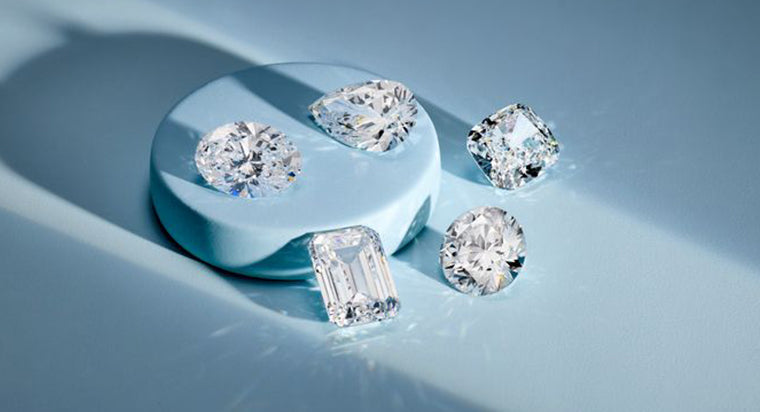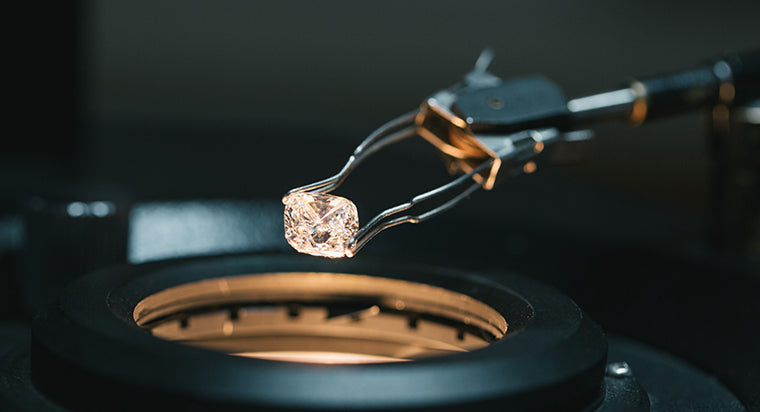Flawless vs. Internally Flawless Diamonds

When considering diamond clarity, internally flawless and flawless diamond engagement rings represent the pinnacle of perfect diamond clarity.
TABLE OF CONTENTS
Diamond Certification Clarity Scales
Although diamond clarity scales vary depending on the laboratory, the Gemological Institute of America (GIA) serves as the industry standard. Flawless (FL) and Internally Flawless (IF) diamonds top the GIA clarity scale, followed by Very, Very Slightly Included (VVS1 and VVS2), Very Slightly Included (VS1 and VS2), Slightly Included (SI1 and SI2), and Included (S1, S2, S3) diamonds.
When determining clarity, the GIA considers the size, nature, position, color, and quantity of clarity characteristics visible under 10× magnification. Flawless diamonds are defined as those with no visible inclusions or blemishes. Internally Flawless (IF) diamonds are those with visible blemishes--but no inclusions. Essentially, the difference between a Flawless diamond engagement ring and an Internally Flawless diamond ring is the presence of blemishes on the diamond's surface. Any surface blemishes such as surface graining, naturals, extra facets, or polish marks would downgrade a diamond from Flawless to Internally Flawless. Thus, a Flawless and Internally Flawless diamond have the same internal clarity, with the differentiating factor exiting as a matter of the polishing of the diamond's facets.
It is nearly impossible for the naked eye to differentiate between flawless and internally flawless diamonds rings. Even trained gemologists using microscopes may have a difficult time. Despite this extreme difficulty in detecting any visual differences between internally flawless diamonds and flawless diamonds, the internally flawless diamond price differs greatly from that of a flawless diamond.
Diamond Clarity Grading Reports
When reading the grading report of an internally flawless diamond, you may see comments such as “minor details of polish are not shown,” “surface graining is not shown,” and “minor details of finish are not shown.” These comments are normal because they refer to the namesake inherent blemishes that distinguish an internally flawless diamond from a flawless diamond. Although these blemishes can be removed with further polishing, diamond cutters choose not to continue polishing in order to avoid decreasing the diamond's carat weight and risk reducing its monetary value. In contrast, any internal inclusions such as surface grain lines that extend into the diamond's body would cause a diamond to fall out of the category of Flawless and Internally Flawless diamonds—and such inclusions cannot be removed with further polishing.
However, despite the grading report's prestigious title of “Flawless,” Flawless diamonds are not truly flawless. In reality, no diamond is truly flawless. As mentioned, the definition of a Flawless diamond is one that has no inclusions visible under 10x magnification. Because diamonds are formed in nature under turbulent conditions of extreme heat and pressure, diamonds cannot be 100% pure. Thus, when using more powerful magnification, such as 60x or 100x, a Flawless diamond engagement ring may actually present visible blemishes.

Benefits to a Flawless Diamond
Other than the psychological satisfaction and a drastic price difference, a flawless diamond engagement ring does not hold greater tangible value than an internally flawless diamond ring. If looking for the greatest visual impact, allocate your budget to a high cut grade, rather than clarity. Ultimately, when choosing between a Flawless and Internally Flawless diamond, the deciding factor is the value you place on a diamond that has been deemed “Flawless” by the judging laboratory.
Best Diamond for your Budget
Clarity is one of the major 4 C's of diamond buying, in addition, to cut, color, and carat.
Watch our company founder help you assess which combination of the 4 C's will yield in the best diamond for your budget.
How to Select your Ideal Diamond
When selecting a diamond, steer clear of focusing too heavily on any one of a diamond's 4C's. It is crucial to find a well balanced diamond that has an optimal balance between cut, clarity, carat, and color.If you need a little help in selecting the perfect diamond, read our step-by-step guide in finding the perfect diamond. This guide will help you narrow down the cut, color, clarity, and carat of your diamond until you arrive at the perfect, attainable gem that suits your desires and your budget.









